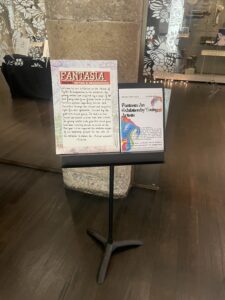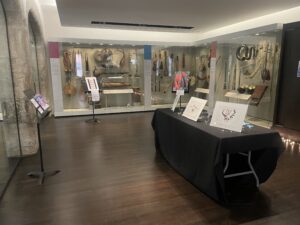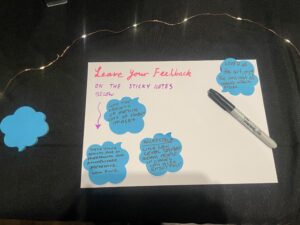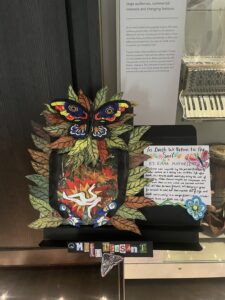Home University of Edinburgh Library Essentials
December 5, 2025
Fantasia: An Exhibition for Young Artists by our Gold Arts Award students
Posted on September 7, 2024 | in Uncategorized | by lbeattieOver the past year, a group of young people between the ages of 14-17 have been completing their Gold Arts Award through our ‘Arts All Around’ programme: a partnership between University of Edinburgh Heritage Collections and the University of Stirling’s Collections. In this blog post, some of our young artists share with us the project they completed for Unit 2 of the Arts Award which requires them to develop their leadership skills and their advice for other young people completing similar projects.
Fantasia: An Exhibition for Young Artists, written by Ella, Emma, Jagoda, Maya and Tanya
Introduction
In the first section of our Arts Award, we mainly focused on looking at different art forms and our own creative projects. We also wrote reviews of exhibitions at the university and elsewhere as well as carrying out work experience placements and writing a debate essay about an arts topic. For the second part of the award, we had to work on our leadership skills and come up with a project together which would allow us to demonstrate these skills. We decide that we’d like to host a exhibition for other young artists as we felt that there were not many opportunities out there for young people to display their work.
Planning
At the start of our planning we researched a few different venues where we could hold our exhibition, ultimately deciding on our first idea of St Cecilia’s Hall as the venue is very accessible in the city centre and we liked the fact that people wouldn’t just have to come for our exhibition but would also be able to look around the museum. From there we met at the venue so we could have a better idea of the space we had and to further our planning. We worked together to come up with a theme for the exhibition by researching other exhibitions and their themes for inspiration and using a generator to give us a few different ideas of themes that we could then build on. We collectively agreed that the theme of Myths felt the best and kept the theme very broad to allow for artists to have more creative liberty. For the submissions to the exhibition we created a Google Form with all the information we needed about the artist’s piece and to reach as many people as possible to try and get submissions from, we sent out a general email to people and made a poster to put up that included information about what the exhibition was and what we were looking for with submissions and a QR to the form.

Intro to the Exhibition
Lead up to exhibition / On the Day
On the day of the exhibition, the group ran into a few issues which we had to solve ourselves using our own initiative. Emma, one of the organisers, had to cancel at the last minute, and Laura couldn’t come before a certain time, meaning we did most of the setting up by ourselves. We were provided with music stands to display artworks on, however more stands were required due to some last minute submissions, so we had to ask the staff at St. Cecilia’s hall to bring more. We also had to solve a few problems regarding technology, as the fairy lights we were using in the displays wouldn’t turn on for a while, however this was fixed after a few attempts. Finally, we had to write extra signs for some people who had submitted art but weren’t able to show up on the day. We used the artists’ form submissions to write descriptions and information about them with the craft supplies provided at the venue.

Some of our display
When the exhibition was being shown, there were Post-it notes set up where people could write feedback on our artworks. The response was very positive, and the number of visitors who came in was higher than expected, making the exhibition a success!

Feedback
Advice for People Planning a Similar Event in future
With these events it is good to plan ahead, do extensive research on the perfect venue, theme and what is needed to put together the exhibition. What is most important is to communicate with your team as a lot can be done in a group, working together can create efficiency and also make it more fun. You have to be open minded, listen to others and learn how to compromise. Of course what is also a key part of planning these events is to be passionate about your project, it keeps you motivated.

One of the works in our exhibition
Reflection
Throughout the planning process we lost track of what each person was in charge of doing. Making sure everyone knows what you are working on is important in a group and getting updates from each other would have been beneficial to everyone. With a few delays we had to move the timeline along & change the dates on the posters but that was handled well and efficiently. Starting the artist form process earlier so that we could exhibit more art by a broader range of individuals would have been beneficial & made the exhibition more substantial but what we had was well received by the turnout. Meeting more often would’ve moved the project quicker but due to the variety in our schedules that was hard to organise. Overall, the exhibit was quite the success & blew our expectations out of the park. Despite the planning sometimes getting muddled, we successfully organised the exhibit and had a great time and turnout!

Another of the works in our exhibition
Collections
 Hill and Adamson Collection: an insight into Edinburgh’s past
My name is Phoebe Kirkland, I am an MSc East Asian Studies student, and for...
Hill and Adamson Collection: an insight into Edinburgh’s past
My name is Phoebe Kirkland, I am an MSc East Asian Studies student, and for...
 Cataloguing the private papers of Archibald Hunter Campbell: A Journey Through Correspondence
My name is Pauline Vincent, I am a student in my last year of a...
Cataloguing the private papers of Archibald Hunter Campbell: A Journey Through Correspondence
My name is Pauline Vincent, I am a student in my last year of a...
Projects
 Cataloguing the private papers of Archibald Hunter Campbell: A Journey Through Correspondence
My name is Pauline Vincent, I am a student in my last year of a...
Cataloguing the private papers of Archibald Hunter Campbell: A Journey Through Correspondence
My name is Pauline Vincent, I am a student in my last year of a...
 Archival Provenance Research Project: Lishan’s Experience
Presentation My name is Lishan Zou, I am a fourth year History and Politics student....
Archival Provenance Research Project: Lishan’s Experience
Presentation My name is Lishan Zou, I am a fourth year History and Politics student....

